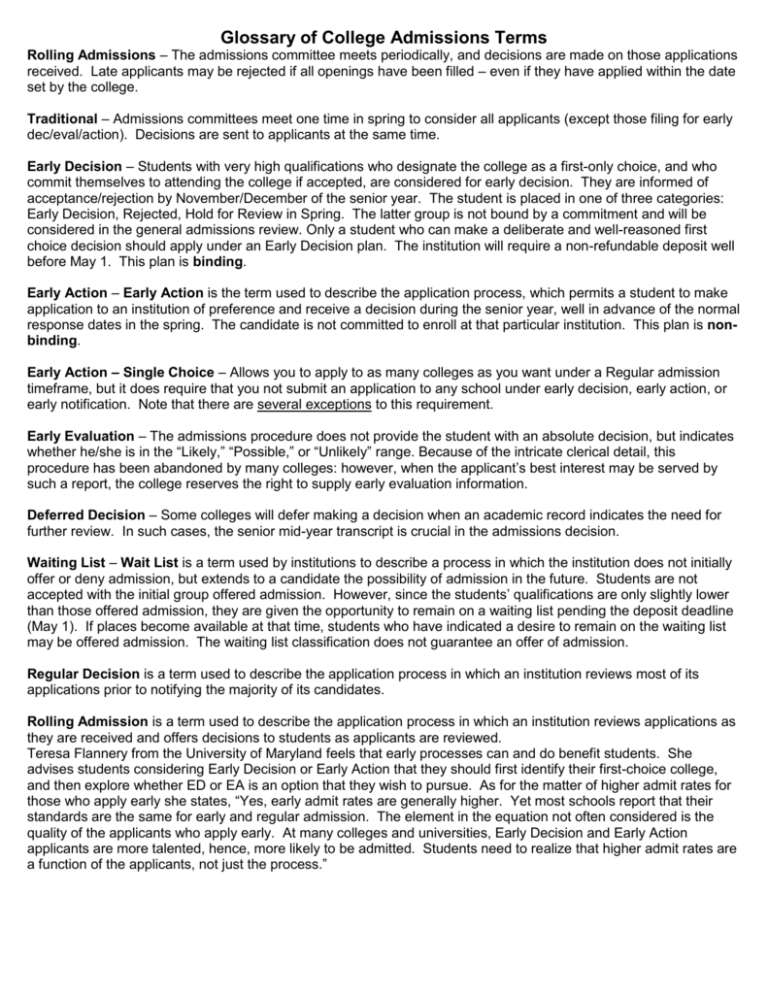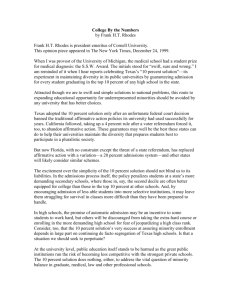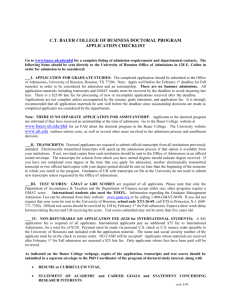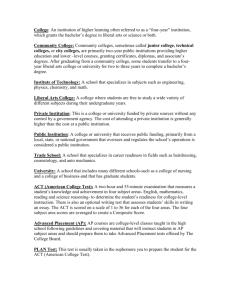Glossary of College Admissions Terms
advertisement

Glossary of College Admissions Terms Rolling Admissions – The admissions committee meets periodically, and decisions are made on those applications received. Late applicants may be rejected if all openings have been filled – even if they have applied within the date set by the college. Traditional – Admissions committees meet one time in spring to consider all applicants (except those filing for early dec/eval/action). Decisions are sent to applicants at the same time. Early Decision – Students with very high qualifications who designate the college as a first-only choice, and who commit themselves to attending the college if accepted, are considered for early decision. They are informed of acceptance/rejection by November/December of the senior year. The student is placed in one of three categories: Early Decision, Rejected, Hold for Review in Spring. The latter group is not bound by a commitment and will be considered in the general admissions review. Only a student who can make a deliberate and well-reasoned first choice decision should apply under an Early Decision plan. The institution will require a non-refundable deposit well before May 1. This plan is binding. Early Action – Early Action is the term used to describe the application process, which permits a student to make application to an institution of preference and receive a decision during the senior year, well in advance of the normal response dates in the spring. The candidate is not committed to enroll at that particular institution. This plan is nonbinding. Early Action – Single Choice – Allows you to apply to as many colleges as you want under a Regular admission timeframe, but it does require that you not submit an application to any school under early decision, early action, or early notification. Note that there are several exceptions to this requirement. Early Evaluation – The admissions procedure does not provide the student with an absolute decision, but indicates whether he/she is in the “Likely,” “Possible,” or “Unlikely” range. Because of the intricate clerical detail, this procedure has been abandoned by many colleges: however, when the applicant’s best interest may be served by such a report, the college reserves the right to supply early evaluation information. Deferred Decision – Some colleges will defer making a decision when an academic record indicates the need for further review. In such cases, the senior mid-year transcript is crucial in the admissions decision. Waiting List – Wait List is a term used by institutions to describe a process in which the institution does not initially offer or deny admission, but extends to a candidate the possibility of admission in the future. Students are not accepted with the initial group offered admission. However, since the students’ qualifications are only slightly lower than those offered admission, they are given the opportunity to remain on a waiting list pending the deposit deadline (May 1). If places become available at that time, students who have indicated a desire to remain on the waiting list may be offered admission. The waiting list classification does not guarantee an offer of admission. Regular Decision is a term used to describe the application process in which an institution reviews most of its applications prior to notifying the majority of its candidates. Rolling Admission is a term used to describe the application process in which an institution reviews applications as they are received and offers decisions to students as applicants are reviewed. Teresa Flannery from the University of Maryland feels that early processes can and do benefit students. She advises students considering Early Decision or Early Action that they should first identify their first-choice college, and then explore whether ED or EA is an option that they wish to pursue. As for the matter of higher admit rates for those who apply early she states, “Yes, early admit rates are generally higher. Yet most schools report that their standards are the same for early and regular admission. The element in the equation not often considered is the quality of the applicants who apply early. At many colleges and universities, Early Decision and Early Action applicants are more talented, hence, more likely to be admitted. Students need to realize that higher admit rates are a function of the applicants, not just the process.”











